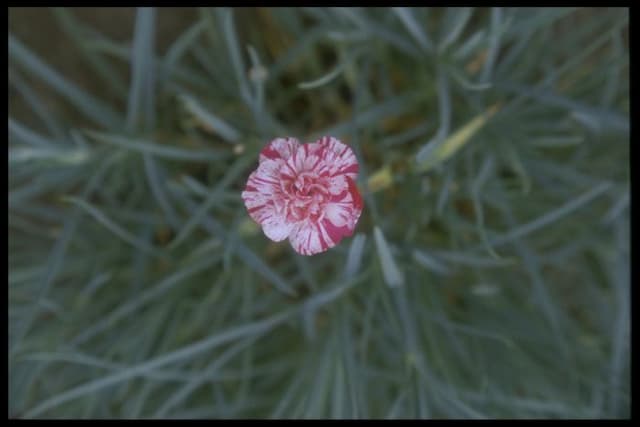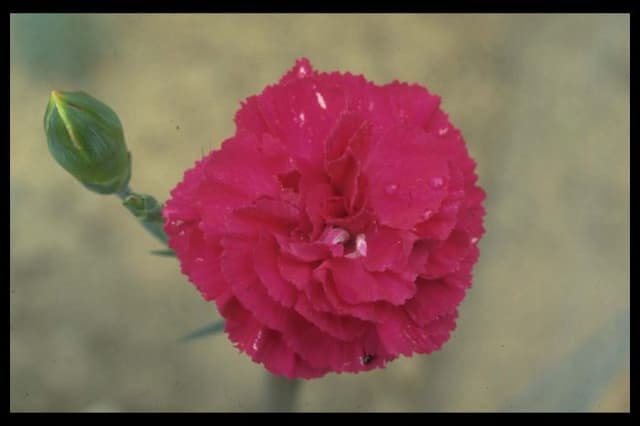Sweet William Dianthus 'Night Star' (p)

ABOUT
The Dianthus 'Night Star', commonly known as Carnation or Pink, exhibits a visually striking appearance with its distinctive flowers and foliage. The blooms of the 'Night Star' are particularly eye-catching, featuring frilled petals that commonly display a mix of pink or red hues centered with a contrasting darker, often purplish, eye or ring that seems to pierce the heart of each flower. Carnation petals can sometimes have a near velvety texture and are known for their durability and longevity, both on the plant and as cut flowers in arrangements. The foliage of the Carnation 'Night Star' is equally attractive, typically displaying a bluish-green to gray-green color, with slender, linear leaves that create a complementary backdrop to the vivid flowers. These leaves are often arranged in a dense fashion, adding to the plant's full and lush appearance. Together, the dramatic flowers and the striking foliage of the Carnation 'Night Star' make it a popular choice for garden enthusiasts seeking to add a splash of bold color and texture to their floral displays.
About this plant
 Names
NamesFamily
Caryophyllaceae.
Synonyms
Pink, Sweet William, Carnation, Gillyflower.
Common names
Dianthus 'Night Star' (p).
 Toxicity
ToxicityTo humans
Dianthus, commonly known as carnation, is not generally considered a toxic plant to humans. Ingesting parts of the plant typically does not lead to poisoning or severe health issues; however, individual sensitivities can cause minor irritations or allergic reactions in some people.
To pets
Carnation is also not typically toxic to pets. However, if ingested in large quantities, it may cause mild gastrointestinal upset, including symptoms like vomiting or diarrhea in sensitive animals. It is always advisable to keep an eye on your pet's behavior after ingesting any plant material, and consult with a veterinarian if you observe any unusual symptoms.
 Characteristics
CharacteristicsLife cycle
Perennials
Foliage type
Evergreen
Color of leaves
Blue-green
Flower color
Pink
Height
1 foot (0.3 meters)
Spread
1 foot (0.3 meters)
Plant type
Herb
Hardiness zones
3-9
Native area
Europe
Benefits
 General Benefits
General Benefits- Aesthetic Appeal: Adds vibrant color and visual interest to gardens with its striking bi-colored flowers.
- Fragrance: Emits a pleasant scent that can enhance the sensory experience in a garden or when used as a cut flower.
- Pollinator Attraction: Attracts beneficial insects such as butterflies and bees, which are vital for pollination.
- Long Blooming Period: Typically blooms from late spring to early fall, providing extended periods of color.
- Low Maintenance: Easy to care for, requiring minimal attention once established, making it ideal for gardeners of all skill levels.
- Drought Tolerance: Once established, it can tolerate periods of dryness, making it suitable for xeriscaping and water-wise gardens.
- Cold Hardy: Can withstand cooler temperatures, making it a good choice for gardens in various climates.
- Versatility: Suitable for a variety of garden settings, including borders, containers, and rock gardens.
- Cut Flowers: The blossoms are suitable for cutting and can be used in floral arrangements.
 Medical Properties
Medical PropertiesThis plant is not used for medical purposes.
 Air-purifying Qualities
Air-purifying QualitiesThis plant is not specifically known for air purifying qualities.
 Other Uses
Other Uses- Dianthus 'Night Star' petals can be used to create natural dyes for fabrics, giving them a soft pink to reddish hue.
- The fragrant flowers can be included in potpourris to add a pleasant scent to rooms.
- Pressed flower art can incorporate Dianthus 'Night Star' petals to create unique designs and preserve the flowers’ beauty.
- These flowers are often used in photography for their brilliant colors and distinct patterns, serving as a subject for botanical photography.
- Dianthus 'Night Star' can serve as an indicator plant in gardens, showing signs of soil health or distress.
- As an ornamental, it can be used in bridal bouquets or boutonnieres for its beauty and fragrance.
- The flowers can be used in crafts, such as making bookmarks or greeting cards, by drying and pressing them.
- Dianthus 'Night Star' plants are useful in educational settings as examples of plant growth, pollination, and horticultural practices.
- They can be grown in small containers as part of a fairy garden or miniature scene due to their compact size.
- The plant’s natural repellent properties make it suitable for companion planting to deter certain pests from more vulnerable plants.
Interesting Facts
 Feng Shui
Feng ShuiThe Dianthus, commonly known as Carnation, is not typically mentioned in classical Feng Shui practice.
 Zodiac Sign Compitability
Zodiac Sign CompitabilityThe Carnation is not used in astrology practice.
 Plant Symbolism
Plant Symbolism- Love: Dianthus flowers are traditionally associated with love and affection, partly due to their enduring fragrance and vibrant colors that are often linked to the heart.
- Admiration: The 'Night Star' variety with its distinctive pattern could symbolize deep admiration for someone's uniqueness and splendor.
- Passion: The bold colors of the Dianthus 'Night Star', especially if it displays deep red hues, can symbolize passion and strong emotions.
- Purity: Dianthus plants can also represent purity and innocence, with the 'Night Star' potentially being associated with the untouched beauty of the night sky.
- Boldness: The striking appearance of Dianthus 'Night Star' can signify boldness or making a bold statement, much like a star against the night sky stands out.
- Devotion: Known for their long-lasting blooms, these flowers may also epitomize strong devotion and commitment in a relationship.
 Water
WaterThe Pinks require watering when the soil surface feels dry to the touch, typically around once a week, but this can vary with weather conditions. They prefer a thorough watering that saturates the root zone; for potted plants, this means continuing to water until it begins to leak from the drainage holes. Approximately one gallon of water per square yard each week should be sufficient during the growing season, although less might be necessary if rainfall is abundant. It's important to not let the plants sit in soggy soil, so ensure good drainage to prevent root rot, particularly in cooler months when plants require less water.
 Light
LightPinks thrive in full sun, which means they should receive at least 6 hours of direct sunlight daily for optimal growth. An ideal spot would be an east or south-facing location where the light is bright and consistent throughout the day. However, they can tolerate some light shade, especially in hotter climates where the afternoon sun can be intense.
 Temperature
TemperaturePinks prefer moderate temperatures and do best when daytime temperatures are between 60 and 70 degrees Fahrenheit. They can tolerate temperatures down to about 40 degrees Fahrenheit but should be protected from frost. Consistent temperatures too high above 80 degrees Fahrenheit can adversely affect the plant. It's important to avoid extreme temperature fluctuations for the health of the plant.
 Pruning
PruningPinks should be pruned to remove spent flowers and encourage a second bloom, generally after the first flowering peak has passed. Light pruning can also help to maintain the shape and dense foliage of the plant. It is often best to prune in the late summer or early fall, however, always leaving some foliage to help protect the plant over the winter. Removing dead or diseased stems anytime is beneficial for the plant's health.
 Cleaning
CleaningAs needed
 Soil
SoilCarnation 'Night Star' thrives in well-draining, loamy soil with a neutral to slightly alkaline pH between 6.5 and 7.5. A mix incorporating compost, peat, and perlite or sand can provide the necessary drainage and nutrient levels for optimal growth.
 Repotting
RepottingCarnation 'Night Star' typically requires repotting every 1-2 years to refresh the soil and accommodate root growth. Timing can vary based on the plant's size and the condition of the soil.
 Humidity & Misting
Humidity & MistingCarnation 'Night Star' prefers moderate ambient humidity but is quite adaptable. It can do well in typical household humidity levels without the need for additional humidity modifications.
 Suitable locations
Suitable locationsIndoor
Ensure bright light, cool temps, and good air circulation for Carnations.
Outdoor
Plant in full sun, use well-draining soil, and space adequately.
Hardiness zone
3-9 USDA
 Life cycle
Life cycleThe life of the Dianthus 'Night Star' (p), commonly known as Pink Dianthus 'Night Star', begins with seed germination that occurs in warm, well-drained soil with plenty of sunlight. Following germination, the seedling stage is marked by the emergence of the plant's initial set of true leaves after the cotyledons (seed leaves). As the plant enters the vegetative stage, it develops a robust foliage system and a strong root network. This stage leads to the flowering phase, where the plant produces its distinctive fragrant flowers, usually in late spring to early summer. After pollination, the plant's flowers develop into capsules that contain seeds, signaling the reproductive stage where these seeds can be dispersed for new plant growth. Finally, in the case of perennials, the plant will enter a period of dormancy in winter, only to re-emerge and repeat the cycle the following growing season.
 Propogation
PropogationPropogation time
Spring-Summer
Dianthus 'Night Star', commonly known as pinks, is best propagated through stem cuttings. This process should be carried out in late spring to early summer. Select a healthy, non-flowering stem and cut a 4 to 6-inch (10 to 15 cm) length, snipping just below a leaf node. Remove the leaves from the lower half of the cutting and dip the cut end into rooting hormone powder to encourage root growth. Plant the cutting in a well-draining soil mixture, ensuring that at least two sets of leaf nodes are buried below the surface. Keep the soil consistently moist and maintain a warm environment to help the cuttings root, which usually takes a few weeks. Once the cuttings have rooted and grown strong enough, they can be transplanted to their final location.




![Pink [Coconut Sundae]](/_next/image?url=https%3A%2F%2Fplants-admin.emdemapps.com%2Fimages%2Fplants%2F%2Fimages%2F604b5d09d4fd1.png&w=640&q=75)




